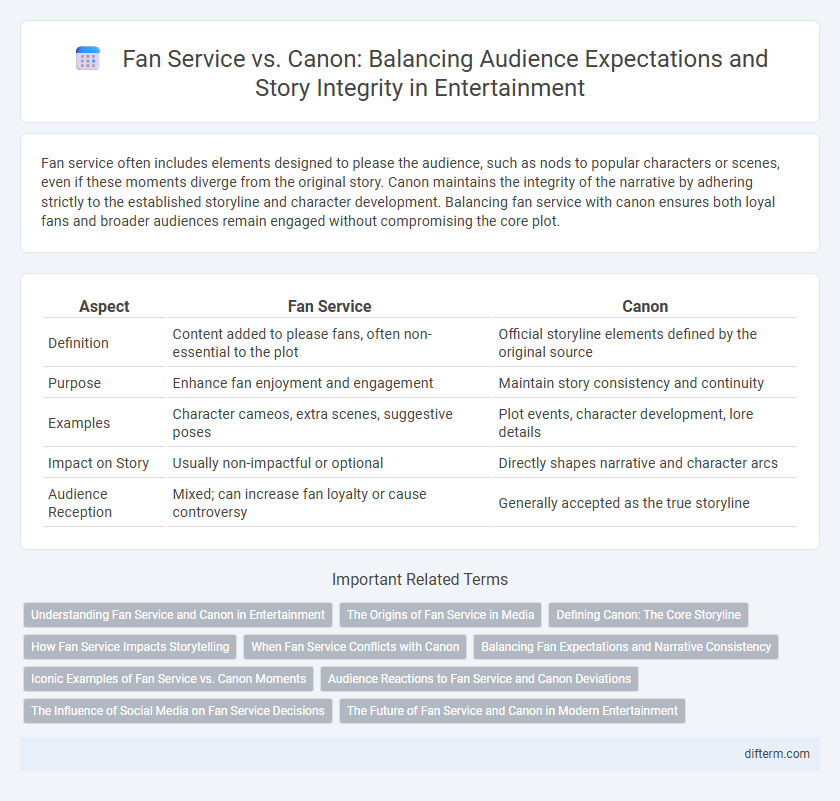Fan service often includes elements designed to please the audience, such as nods to popular characters or scenes, even if these moments diverge from the original story. Canon maintains the integrity of the narrative by adhering strictly to the established storyline and character development. Balancing fan service with canon ensures both loyal fans and broader audiences remain engaged without compromising the core plot.
Table of Comparison
| Aspect | Fan Service | Canon |
|---|---|---|
| Definition | Content added to please fans, often non-essential to the plot | Official storyline elements defined by the original source |
| Purpose | Enhance fan enjoyment and engagement | Maintain story consistency and continuity |
| Examples | Character cameos, extra scenes, suggestive poses | Plot events, character development, lore details |
| Impact on Story | Usually non-impactful or optional | Directly shapes narrative and character arcs |
| Audience Reception | Mixed; can increase fan loyalty or cause controversy | Generally accepted as the true storyline |
Understanding Fan Service and Canon in Entertainment
Fan service in entertainment refers to elements specifically designed to please fans, often through callbacks, character interactions, or visuals that may not align with the official storyline or canon. Canon represents the official, established narrative and character developments sanctioned by the creators or rights holders of a series. Understanding the distinction between fan service and canon helps audiences appreciate content without confusing fan-oriented additions with the core story continuity.
The Origins of Fan Service in Media
Fan service originated in the late 20th century as a strategy in anime and manga to captivate audiences by including content that appeals specifically to dedicated fans, often through suggestive visuals or character interactions not essential to the plot. This practice diverges from canon, which strictly adheres to the official storyline and character development established by the creators. Early examples, such as *Neon Genesis Evangelion* and *Sailor Moon*, popularized fan service by blending narrative depth with moments designed purely to please fans, influencing its prevalence across various media forms.
Defining Canon: The Core Storyline
Canon defines the core storyline and essential events that shape a franchise's official narrative, distinguishing it from fan service elements designed solely to please the audience without impacting the main plot. Fan service often includes non-canonical scenes or character interactions that entertain but do not affect the progression or continuity of the established universe. Maintaining a clear distinction between canon and fan service ensures story integrity and preserves the creator's original vision.
How Fan Service Impacts Storytelling
Fan service can both enhance and detract from storytelling by prioritizing audience gratification over narrative coherence, often introducing scenes or elements that disrupt plot flow and character development. While it boosts engagement and fan loyalty through recognizable callbacks or appealing visuals, excessive fan service risks alienating viewers seeking a cohesive and immersive experience. Balancing fan service with adherence to canon is essential for maintaining story integrity and satisfying diverse audience expectations.
When Fan Service Conflicts with Canon
Fan service often introduces elements that captivate the audience but can diverge from established canon, creating narrative inconsistencies. These conflicts may disrupt character development or plot coherence, impacting the story's authenticity and fan investment. Balancing fan service with canon integrity requires careful consideration to maintain the original vision while satisfying audience expectations.
Balancing Fan Expectations and Narrative Consistency
Balancing fan service and canon requires maintaining narrative consistency while addressing fan expectations to enhance engagement without compromising story integrity. Effective fan service integrates popular elements that resonate with the audience, reinforcing character development and plot progression to keep the narrative cohesive. Prioritizing canon ensures that plotlines remain believable and faithful to the original vision, preventing fan service from undermining the story's core themes and continuity.
Iconic Examples of Fan Service vs. Canon Moments
Iconic examples of fan service versus canon moments highlight the tension between creators' original narratives and audience expectations, such as the controversial "Naruto" kiss scenes that cater to fan desires yet deviate from the series' core plot. In "Star Wars," the romantic tension between Han Solo and Princess Leia exemplifies canonical storytelling that also satisfies fan enthusiasm without undermining the overarching saga. The distinction between fan service in "Dragon Ball Z," with exaggerated power-ups and character pairings, contrasts with the canonical emotional arcs driving the storyline's development.
Audience Reactions to Fan Service and Canon Deviations
Audience reactions to fan service often vary, with some fans embracing the playful nods to popular characters or tropes, while purists may criticize deviations from established canon for disrupting narrative continuity. Fan service can enhance viewer engagement by providing relatable Easter eggs, but excessive reliance risks alienating dedicated fans who value authenticity in storytelling. Balancing fan service and canon fidelity remains a critical challenge for creators aiming to satisfy diverse audience expectations within entertainment franchises.
The Influence of Social Media on Fan Service Decisions
Social media platforms have transformed fan service decisions by amplifying direct fan feedback, enabling creators to gauge audience preferences instantly and adjust storylines or character portrayals accordingly. The real-time interaction on Twitter, Instagram, and fan forums drives content that often balances between canon consistency and fan expectations, creating dynamic narratives that resonate with active communities. Data analytics from social media engagement inform production teams, illustrating how fan service can boost popularity without undermining canonical integrity.
The Future of Fan Service and Canon in Modern Entertainment
Fan service continues to shape audience engagement by integrating popular, non-canonical elements that enhance emotional connections without altering core storylines. Modern entertainment increasingly balances fan service with canonical integrity through immersive experiences like interactive narratives and transmedia storytelling. Advances in technology and audience feedback mechanisms drive creators to innovate ways of blending fan service and canon, ensuring authenticity while satisfying diverse fan expectations.
fan service vs canon Infographic

 difterm.com
difterm.com